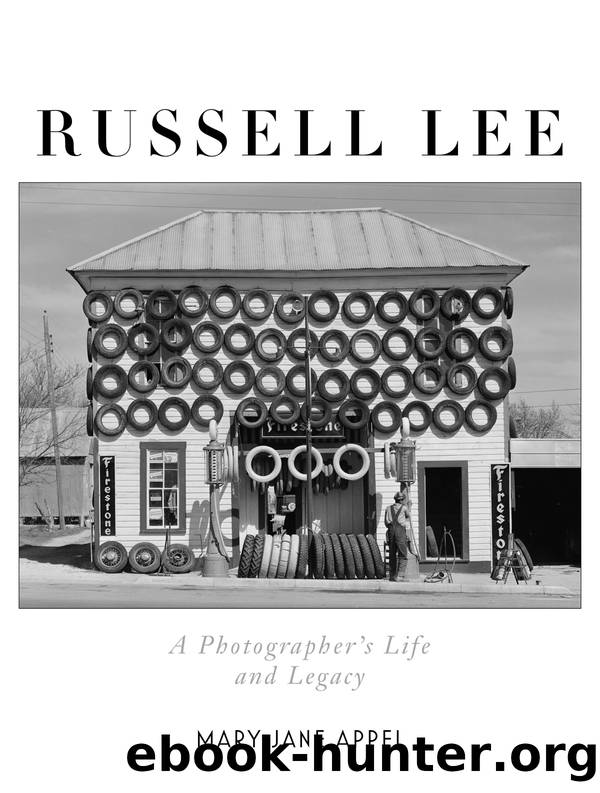Russell Lee by Mary Jane Appel

Author:Mary Jane Appel
Language: eng
Format: epub
Publisher: Liveright Publishing Corporation
Published: 2020-10-07T00:00:00+00:00
70. Tent home of family living in community camp. Oklahoma City, Oklahoma, July 1939.
Leeâs gritty images offer a visual equivalent of Steinbeckâs descriptions in his âHarvest Gypsiesâ series. They show people living in make-do shelters, shacks, and tents cobbled together from scraps (fig. 70). Some camped out in the open, with their bedroll on the ground. Others slept directly on dirt. Clothing was threadbare or inadequate: children lacked shoes so that broken glass and other debris punctured the soles of their feet. Most of the food in the camp came from charity, scavenging, or theft. The local hospital donated some and migrants retrieved provisions from trash dumps or the discard pile at a vegetable packing business. At one tent home, Lee pictured a boy eating an overripe cantaloupe; both were covered in flies. Out of desperation, camp residents stole into the stockyards in the early morning to milk the cows.
Lee found some camp residents who resorted to other means of support, outside what they could find on WPA or as day laborers. One man became a âtrasherâ (or garbage collector) and Lee found his children, clothed in burlap sacks, playing with the rubbish their father picked up. Others made their living by catching crawfish to sell for bait or by collecting castoff vegetable crates and selling them to their neighbors for building material.
Amid these distressing conditions, Lee found gestures of pride and marks of hope. In a tattered and trash-strewn three-sided tent, a woman pressed an article of clothing on her ironing board. Elsewhere, amid a row of shacks, children set up a âpop standâ made of wooden crates and burlap, where they sold âsoda popâ for a penny a cup; both the penny and the pop were likely make-believe.
In addition to these semi-permanent encampments, Lee also visited temporary ones. Near Prague, Oklahoma, he found two migrant families stopped along the road under the shade of a tree. In contrast to Mays Avenue residents, both families were well provisioned and mobile. One prepared an evening meal of fatback and potatoes while the other worked on their automobile. Lee watched them block up the front wheel, remove the crankcase, and put bolts in the connecting rod. He noted that a member of the second family was a migrant steeplejack and âwhen he secures a job, the entire family, consisting of his father and mother, and wife and sister, all help with the painting.â13
While interacting with the steeplejackâs family, Lee created one of the most evocative images in his Oklahoma series: Migrant worker looking through the back window of automobile (fig. 71). Lee captured the steeplejackâs sister as she paused in the backseat of the family car and glanced over her shoulder, through the carâs rear window, beyond the picture plane. Itâs another of his frame-within-a-frame compositions, a visual device he favored (figs. 1, 8, 27, 34, 35, 50aâb, 76, 100).
By picturing her within the automobile, Lee created a universal migrant portrait. The car, a symbol of the highway, will transport this family to their next opportunity.
Download
This site does not store any files on its server. We only index and link to content provided by other sites. Please contact the content providers to delete copyright contents if any and email us, we'll remove relevant links or contents immediately.
The Light of Days by Judy Batalion(829)
The Crime Book by DK(704)
Chasing the Thrill by Daniel Barbarisi(658)
1312, Among the Ultras by James Montague(586)
The Doctor Who Fooled the World by Brian Deer(565)
E.R. Nurses by James Patterson(560)
Till Murder Do Us Part by James Patterson(559)
Invention by James Dyson(559)
The Complete Correspondence 1928-1940 by Theodor W. Adorno & Walter Benjamin(505)
Climb by Susan Spann(490)
Mind Games by Neville Southall(479)
The Reporter by Mark Paul Smith(476)
Space 2069 by David Whitehouse(475)
The Dream Architects by David Polfeldt(475)
Surely you Ìre joking, Mr Feynman by Richard Feynman(459)
If You Should Fail by Joe Moran(442)
Masterful Marks: Cartoonists Who Changed the World by Monte Beauchamp(431)
The 'Wolfman' by Sigmund Freud & Sigmund Freud(429)
Banking and Beyond by Unknown(422)
